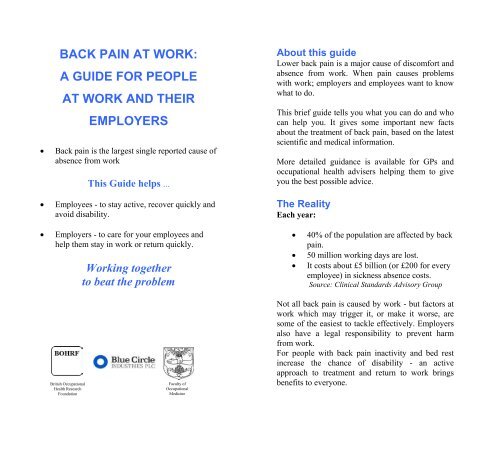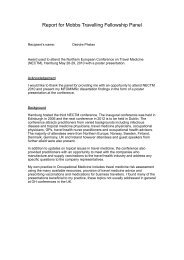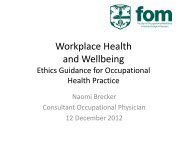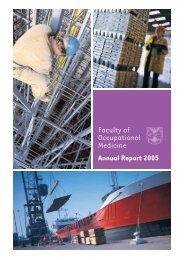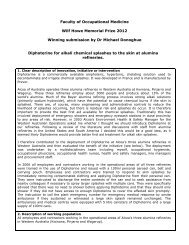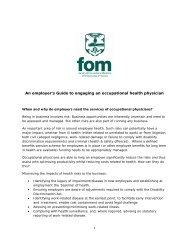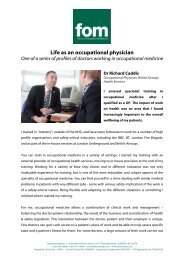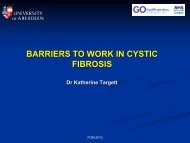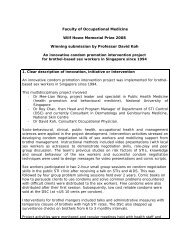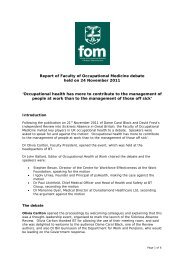BACK PAIN AT WORK: - The British Occupational Health Research ...
BACK PAIN AT WORK: - The British Occupational Health Research ...
BACK PAIN AT WORK: - The British Occupational Health Research ...
Create successful ePaper yourself
Turn your PDF publications into a flip-book with our unique Google optimized e-Paper software.
<strong>BACK</strong> <strong>PAIN</strong> <strong>AT</strong> <strong>WORK</strong>:<br />
A GUIDE FOR PEOPLE<br />
<strong>AT</strong> <strong>WORK</strong> AND THEIR<br />
EMPLOYERS<br />
• Back pain is the largest single reported cause of<br />
absence from work<br />
This Guide helps ...<br />
• Employees - to stay active, recover quickly and<br />
avoid disability.<br />
• Employers - to care for your employees and<br />
help them stay in work or return quickly.<br />
Working together<br />
to beat the problem<br />
About this guide<br />
Lower back pain is a major cause of discomfort and<br />
absence from work. When pain causes problems<br />
with work; employers and employees want to know<br />
what to do.<br />
This brief guide tells you what you can do and who<br />
can help you. It gives some important new facts<br />
about the treatment of back pain, based on the latest<br />
scientific and medical information.<br />
More detailed guidance is available for GPs and<br />
occupational health advisers helping them to give<br />
you the best possible advice.<br />
<strong>The</strong> Reality<br />
Each year:<br />
• 40% of the population are affected by back<br />
pain.<br />
• 50 million working days are lost.<br />
• It costs about £5 billion (or £200 for every<br />
employee) in sickness absence costs.<br />
Source: Clinical Standards Advisory Group<br />
<strong>British</strong> <strong>Occupational</strong><br />
<strong>Health</strong> <strong>Research</strong><br />
Foundation<br />
Faculty of<br />
<strong>Occupational</strong><br />
Medicine<br />
Not all back pain is caused by work - but factors at<br />
work which may trigger it, or make it worse, are<br />
some of the easiest to tackle effectively. Employers<br />
also have a legal responsibility to prevent harm<br />
from work.<br />
For people with back pain inactivity and bed rest<br />
increase the chance of disability - an active<br />
approach to treatment and return to work brings<br />
benefits to everyone.
Employers - What can you do?<br />
At the Workplace<br />
• Consultation is important. Involve<br />
employees / trade unions when you develop<br />
measures to combat back pain:<br />
This joint approach has proved effective in<br />
reducing the impact of back pain at work.<br />
Together with your staff / trade unions, review the<br />
need for any workplace back care or occupational<br />
health advice. An adviser can help you to improve<br />
all aspects of back pain management and put you<br />
in touch with the rest of the health care system.<br />
• Ensure that work activities are comfortable<br />
and not making unreasonable physical<br />
demands:<br />
<strong>The</strong> Manual Handling Regulations (1992) and the<br />
Display Screen Equipment Regulations (1992)<br />
and associated guidance explain how to do this, as<br />
well as defining your legal duties.<br />
Discuss pace, load and rotation of work with<br />
experienced workers / trade union safety<br />
representatives and with occupational health or<br />
back care advisers.<br />
• <strong>Research</strong> shows that some widely used<br />
approaches do not work:<br />
<strong>The</strong>re are no valid methods of pre-placement<br />
screening which detect those at risk.<br />
A history of back pain should not generally be a<br />
reason for refusing employment.<br />
Lumbar supports (back belts) do not protect<br />
against back pain.<br />
• Explain that you want to help people<br />
recover. Encourage early reporting of back<br />
pain if it is causing problems at work:<br />
Set up a system which deals promptly with reports<br />
of back pain.<br />
Review these reports to see if your prevention<br />
measures can be improved.<br />
If anyone reporting back pain is seeing their GP,<br />
either write a note or suggest that they tell the GP<br />
that you are ready to support treatment aimed at a<br />
rapid return to full activities. This will usually be<br />
based on the Royal College of General<br />
Practitioners guidelines.<br />
• Talk with people who have back pain.<br />
Discuss whether their job needs to be<br />
adapted to help them return quickly to
• Full activities. Consider solutions such as<br />
rest pauses, task rotation, handling aids and<br />
extra help from colleagues.<br />
Make sure the work can be done safely.<br />
Give help with particular tasks if the job cannot be<br />
changed.<br />
Don't insist on freedom from pain before someone<br />
resumes normal work - it may delay recovery.<br />
Keep a cheek on progress and be prepared to<br />
make further adjustments.<br />
Someone is absent<br />
• Make contact as soon as possible and keep in<br />
touch with them until return. Tell them you<br />
are ready to help if necessary.<br />
• Arrange a meeting to discuss how their job<br />
could be adapted temporarily to help them<br />
return to full activities. Stress that you want<br />
to help recovery. Keep in mind that<br />
inactivity and bed rest can lead to the<br />
development of disability.<br />
• Ask if you can have consent to contact their<br />
GP to discuss how you might help with plans<br />
for return to work.<br />
Absence of more than 4 weeks<br />
• <strong>The</strong> emphasis should change to an active<br />
programme of rehabilitation.<br />
If you have access to an occupational health<br />
adviser ask them to sort out arrangements.<br />
<strong>The</strong> longer the time off work the greater the<br />
chance of damage to long term quality of life. <strong>The</strong><br />
chance of ever returning to work also reduces<br />
(50% of people return at six months, and only 5%<br />
after one year).<br />
<strong>The</strong> effectiveness of rehabilitation reduces rapidly<br />
the longer it is delayed.<br />
Some NHS Trusts provide rehabilitation<br />
programmes.<br />
• Find out if the NHS can provide what you<br />
need locally. If not, it may be possible to<br />
make arrangements with your employers'<br />
liability or private medical insurer. It is best<br />
to do this before an urgent need arises.<br />
• Liaise with the rehabilitation team to find the<br />
best way of supporting a return to work.
Employees - Do you have back pain?<br />
• Back pain is common: it often settles down<br />
quickly and usually doesn't mean your back is<br />
damaged.<br />
• In many cases taking time off work won't help. In<br />
fact, inactivity can make the problem worse.<br />
• If back pain is causing you problems at work<br />
report this to your employer. Work together on<br />
possible ways to deal with it:<br />
o see if your normal work can be done in a<br />
better way e.g. by better handling methods,<br />
and use of mechanical aids.<br />
o until you can resume with normal work, is<br />
there anything else you can do which is easier<br />
for your back?<br />
o if you have access to an occupational health<br />
or back care adviser at work they can give<br />
you advice based on carefully researched<br />
guidelines. If not and your pain is recurring<br />
and causing problems see your General<br />
Practitioner who also has research based<br />
guidelines.<br />
• If you have to be off work don't stop using your<br />
back, and don't stay in bed, unless your doctor<br />
tells you to. Inactivity or bed rest can make your<br />
back worse.<br />
• <strong>The</strong> Back Book (published by <strong>The</strong> Stationery<br />
Office) has helpful advice on back pain. Your GP<br />
or employer may be able to give you a copy, or<br />
you can order it from a book shop.<br />
More information<br />
• Guidelines for occupational health and<br />
workplace back care advisers are available<br />
in a free leaflet, <strong>Occupational</strong> <strong>Health</strong><br />
Guidelines for the Management of Low Back<br />
Pain at Work. Copies from: <strong>The</strong> Faculty of<br />
<strong>Occupational</strong> Medicine, 6 St Andrew's<br />
Place, Regent's Park, London NW1 4LB.<br />
(A4 stamped addressed envelope required).<br />
• A review of the evidence by Prof. Gordon<br />
Waddell and Prof. Kim Burton together with<br />
more detailed recommendations prepared by<br />
an inter-professional working group and<br />
published by the Faculty of <strong>Occupational</strong><br />
Medicine on which the above guidelines are<br />
based, is available at £15 per copy subject to<br />
payment with order from the same address as<br />
above. Also at: http://www.facoccmed.ac.uk.<br />
• Guidelines for GPs are available from: <strong>The</strong><br />
Royal College of General Practitioners, 14<br />
Prince's Gate, Hyde Park, London SW7 1PU<br />
Also at http://www.rcgp.org.uk.<br />
Sponsorship for the review, the professional<br />
guidelines and this guide was provided by Blue<br />
Circle Industries PLC, through the <strong>British</strong><br />
<strong>Occupational</strong> <strong>Health</strong> <strong>Research</strong> Foundation and<br />
the Faculty of <strong>Occupational</strong> Medicine, as their<br />
1999 Community Project of the Year.<br />
MARCH 2000


